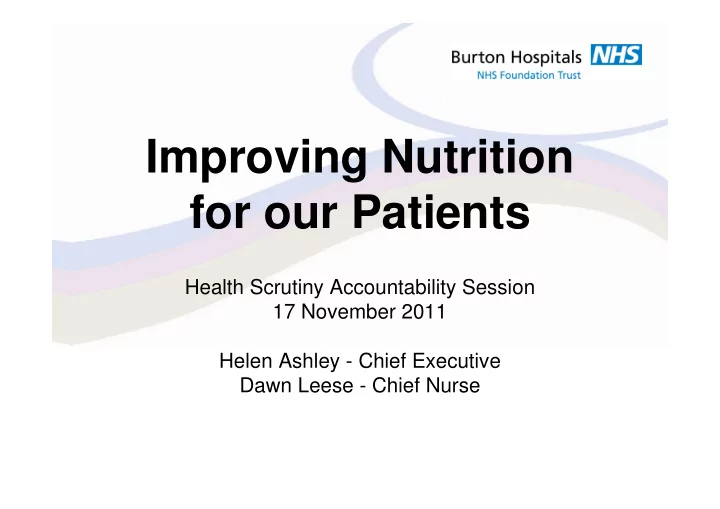

Improving Nutrition for our Patients Health Scrutiny Accountability Session 17 November 2011 Helen Ashley - Chief Executive Dawn Leese - Chief Nurse
Objectives • To outline our aims and standards relation to nutrition in hospital • To share the approach we have taken to making improvements • To provide a summary of actions we have taken • To share how we measure the impact of our interventions
Why is this even an issue in hospitals? Malnutrition is an under-recognised and under-treated problem, with more than 3 million people at any one time in the UK malnourished (Elia et al 2009). A nutritional screening survey, (Russell et al 2009) identified that 28 per cent of people admitted to hospital were at risk of malnutrition and that 30 per cent of residents in care were malnourished. This percentage increases once patients have been in hospital for one week. Improving hydration brings well-being and quality of life for patients. It can allow reduced use of medication and prevent illness (NPSA 2009). Routine screening for malnutrition and risk of malnutrition is now recommended by government and professional organisations The Care Quality Commission (CQC) states that people using health services are supported to have adequate nutrition and hydration.
What is our aim? Burton Hospitals NHS Foundation Trust strives to ensure that no patients suffer from malnutrition or dehydration and their recovery is enhanced by appropriate and targeted nutritional assessment and treatment.
Approach - Joint Working • Lead for Nutrition (Nursing) • Medical colleagues • Head Nurses/ Matrons/Ward Managers • Dietetics (Ward based Dietitian) • Speech and Language Therapy • Catering
Identifying the Standards • Nutrition and Hydration Policy • Enteral tube feeding policy and charts adhering to NPSA alert • Parentral Nutrition Guidelines • Standardised approach on all wards
Training • Training for Healthcare Assistants • Training for Student Nurses • Dedicated nutrition intranet site for staff to access • MUST assessment updates for Qualified Nurses • Enteral Feeding Training • Ward based training as requested • Patient story based development day
Catering Service • Food Production in-house • Food availability 24 hours (Kitchens open 12 hours) • Provide cook/chill service and A la carte • Supply to external organisations • Wide variety of menu options • Diabetic / Halal / Soft / Puree / Gluten free • Puree diet provided in an A la Carte style following SLT review • Catering staff able to meet individual needs (eg. allergy) • Packed lunch service for patients going off-site
Standardised approach • MUST assessment on • Red Tray Liner admission • Red knife and fork symbol • Standardised 5 day diet chart above bed • Standardised Fluid Balance • Planning meal delivery at ward Chart level • Referral to Dietician with a • Identified Nurse/Assistant score of 2 or more Practitioner/HCA at each mealtime to ensure patients all • Weekly MUST assessment have meals and are enjoying it • Care plan based on MUST • Protected mealtimes score • MUST score shared with community staff on discharge • Written information on discharge if necessary
Protected Mealtimes “Do you need to enter now?” • Reduces non-essential activity at mealtimes • All wards, for all meals • Times available on intranet site for all staff to view • Patient and visitor information in each area • Pilot of banner on one ward
Monitoring Standards • Quality Metrics monthly ( 10 patients per ward) • Patient experience metric monthly (real time) • 3 Monthly Mealtime Audit on each ward • PEAT audit • Matrons Walk Around • Monitoring of Wastage • Trust Board responsibility for policy compliance • Observations of care • Chief Nurse visit to ward and kitchens to observe meal production and provision to patients
How are we doing?
Metrics results…… • April 71% to Oct 89% • 2 green, 10 amber and 4 red Still more to do to ensure standards consistently achieved in all areas with a particular focus on re-assessment
• The CQC undertook a Dignity and Nutrition for Older People in April 2011 • They found that Queens Hospital was meeting both of the essential standards of quality and safety reviewed • “People were provided with a good choice of nutritious food and drinks, and offered enough time to eat without interruption”
Nutrition - CQUIN • The Trust has chosen to improve nutrition as a CQUIN target for 2011-2012
CQUIN Performance • Protected mealtimes for all meals displayed on the door? 100% • Patient information available on the ward regarding protected mealtimes? 86% • Red knife and fork symbols used for patients who need help to eat? 75% • Are patients who require help to eat able to receive it within 15 minutes? 100%
Observations of care • Chief nurse announced an unannounced visits • Trust Board ward visits • Matron rounds daily • Head nurse spots checks • Quarterly audits of protected mealtimes
Areas for Improvement • Exploring the opportunity of using volunteers to assist at mealtimes • Protected Mealtimes banners for all ward • Red tray (liners) • Nutrition metric at 95% or above all wards
Recommend
More recommend